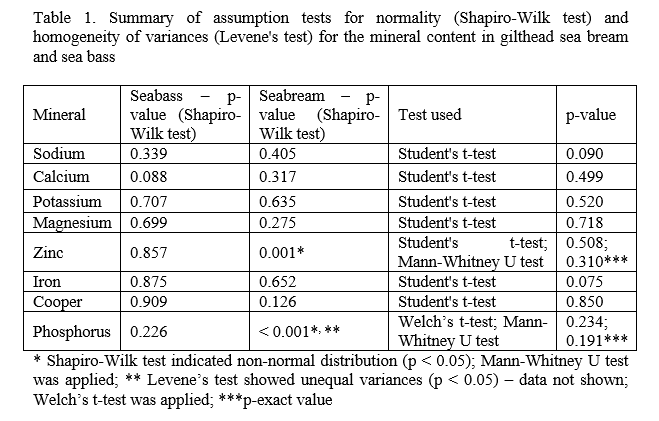DIFFERENCES IN THE MINERAL COMPOSITION OF THE TWO MOST COMMONLY FARMED FISH SPECIES IN THE ADRIATIC SEA
Introduction
Global aquaculture production reached a record high of 130.9 million tons in 2022, of which finfish accounted 65%. Predominant finfish products in Mediterranean countries include European seabass (Dicentrarchus labrax L.) and sea bream (Sparus aurata L.), which are valued for their high protein and mineral content and contribute to the increase in annual per capita consumption. In this study, the proximal mineral composition of farmed sea bass and gilthead sea bream from the Adriatic Sea was determined over a one-year period to assess possible species-specific differences in mineral content (p < 0.05).
Materials and methods
Seven representative individual samples per species were analyzed to determine the eight minerals (Na, Ca, K, Mg, Zn, Fe, Cu and P). They were quantified (mg/kg) using flame atomic absorption spectroscopy (200 Series A4 with SPS 4 Auto-Sampler, Agilent Technologies, USA). Normality was tested using the Shapiro-Wilk test and homogeneity of variance using the Levene test. As all minerals showed homogeneity of variance (p > 0.05), with the exception of phosphorus, the Welch test was used for this mineral. Due to deviations from normality, the Mann-Whitney U-test was used for zinc and phosphorus, while the Student’s t-test was used for all other minerals.
Results
No statistically significant differences in mineral content were found between the two species (p > 0.05), indicating a comparable mineral profile and general richness in essential minerals in both species (Table 1). These results are consistent with previous studies and confirm the comparable nutritional value of these two economically important marine species and the variability in their composition throughout the year.
